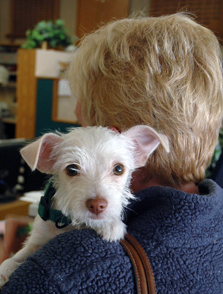Sebaceous Adenomas
by Nancy Kay, DVM
 One cannot discuss lumps and bumps in dogs without talking about sebaceous adenomas. These are, far and away, the most common benign skin tumors in dogs. Most dogs will develop at least a couple of them by the time they are senior citizens.
One cannot discuss lumps and bumps in dogs without talking about sebaceous adenomas. These are, far and away, the most common benign skin tumors in dogs. Most dogs will develop at least a couple of them by the time they are senior citizens.
Sebaceous glands are microscopic structures found just beneath the skin surface. They secrete an oily substance called sebum that is transported to the skin surface via microscopic ducts. Adenomas can arise from the gland or the duct, and can develop anywhere on a dog’s body.
Sebaceous adenomas tend to be small, no more than ¼ to ½ of an inch in size. They may appear round or they can have a wart-like appearance. These benign growths occur primarily in middle-aged and older dogs. Any breed can develop sebaceous adenomas, but certain breeds are particularly predisposed: English Cocker Spaniels, Cocker Spaniels, Samoyeds, Siberian Huskies, Alaskan Malamutes, West Highland White Terriers, Cairn Terriers, Dachshunds, Miniature Poodles, Toy Poodles, Shih Tzus, Basset Hounds, Beagles, and Kerry Blue Terriers.
Because of their benign nature, the vast majority of sebaceous adenomas require no treatment whatsoever. Just about as soon as two or three are surgically removed, two or three more will develop. Surgically chasing sebaceous adenomas accomplishes nothing more than turning a dog into a patchwork quilt. There are some exceptions to the general rule of leaving sebaceous adenomas alone, and they are as follows:
Does your dog have any sebaceous adenomas?
CREDIT:
Dr. Nancy Kay, DVM Diplomate, American College of Veterinary Internal Medicine.
Recipient, American Animal Hospital Association 2009 Animal Welfare and Humane Ethics Award Recipient, 2009 Dog Writers Association of America Award for Best Blog Recipient, 2009 Eukanuba Canine Health Award
 Author of Speaking for Spot: Be the Advocate Your Dog Needs to Live a Happy, Healthy, Longer Life
Author of Speaking for Spot: Be the Advocate Your Dog Needs to Live a Happy, Healthy, Longer Life
Website: http://speakingforspot.com
Spot’s Blog: "http://www.speakingforspot.com/blog
Email: dr.kay@speakingforspot.com
Become a Facebook Fan: Facebook Fan - Nancy-Kay
 One cannot discuss lumps and bumps in dogs without talking about sebaceous adenomas. These are, far and away, the most common benign skin tumors in dogs. Most dogs will develop at least a couple of them by the time they are senior citizens.
One cannot discuss lumps and bumps in dogs without talking about sebaceous adenomas. These are, far and away, the most common benign skin tumors in dogs. Most dogs will develop at least a couple of them by the time they are senior citizens.Sebaceous glands are microscopic structures found just beneath the skin surface. They secrete an oily substance called sebum that is transported to the skin surface via microscopic ducts. Adenomas can arise from the gland or the duct, and can develop anywhere on a dog’s body.
Sebaceous adenomas tend to be small, no more than ¼ to ½ of an inch in size. They may appear round or they can have a wart-like appearance. These benign growths occur primarily in middle-aged and older dogs. Any breed can develop sebaceous adenomas, but certain breeds are particularly predisposed: English Cocker Spaniels, Cocker Spaniels, Samoyeds, Siberian Huskies, Alaskan Malamutes, West Highland White Terriers, Cairn Terriers, Dachshunds, Miniature Poodles, Toy Poodles, Shih Tzus, Basset Hounds, Beagles, and Kerry Blue Terriers.
Because of their benign nature, the vast majority of sebaceous adenomas require no treatment whatsoever. Just about as soon as two or three are surgically removed, two or three more will develop. Surgically chasing sebaceous adenomas accomplishes nothing more than turning a dog into a patchwork quilt. There are some exceptions to the general rule of leaving sebaceous adenomas alone, and they are as follows:
Surgical removal is warranted for those sebaceous adenomas that recurrently bleed or become infected because of self-trauma (the dog bites or chews at them), or because they get in the way of the groomer’s clippers.
Some sebaceous adenomas secrete oodles of sebum creating the constant appearance of an oil slick on the dog’s hair coat. The grease rubs off on hands, furniture, clothing, and anything else the dog contacts. No fun!
Some sebaceous adenomas are pretty darned unsightly, looking like warty little aliens poking through the hair coat. Although this is not bothersome for the dog, it can pose a significant psychological issue for the person living with that dog.
If a mass believed to be a sebaceous adenoma is growing or changing in appearance, it is important to ask your veterinarian to have another look. What was thought to be a benign adenoma may be its less common cancerous cousin, a sebaceous carcinoma.
Does your dog have any sebaceous adenomas?
CREDIT:
Dr. Nancy Kay, DVM Diplomate, American College of Veterinary Internal Medicine.
Recipient, American Animal Hospital Association 2009 Animal Welfare and Humane Ethics Award Recipient, 2009 Dog Writers Association of America Award for Best Blog Recipient, 2009 Eukanuba Canine Health Award
 Author of Speaking for Spot: Be the Advocate Your Dog Needs to Live a Happy, Healthy, Longer Life
Author of Speaking for Spot: Be the Advocate Your Dog Needs to Live a Happy, Healthy, Longer LifeWebsite: http://speakingforspot.com
Spot’s Blog: "http://www.speakingforspot.com/blog
Email: dr.kay@speakingforspot.com
Become a Facebook Fan: Facebook Fan - Nancy-Kay
